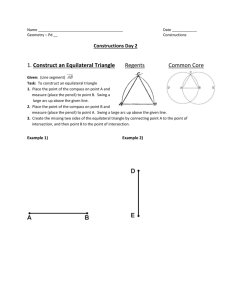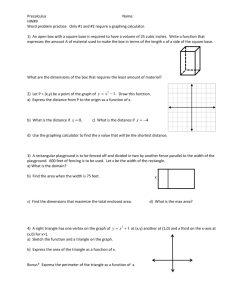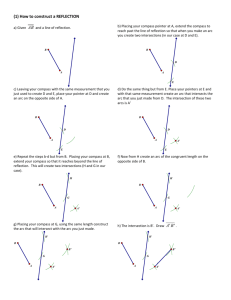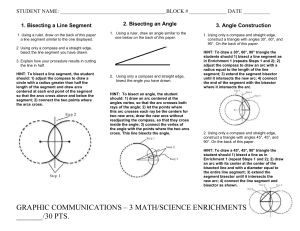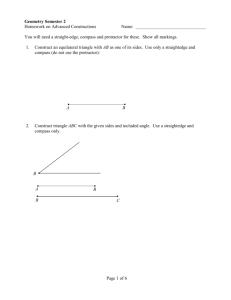How to construct triangles
advertisement
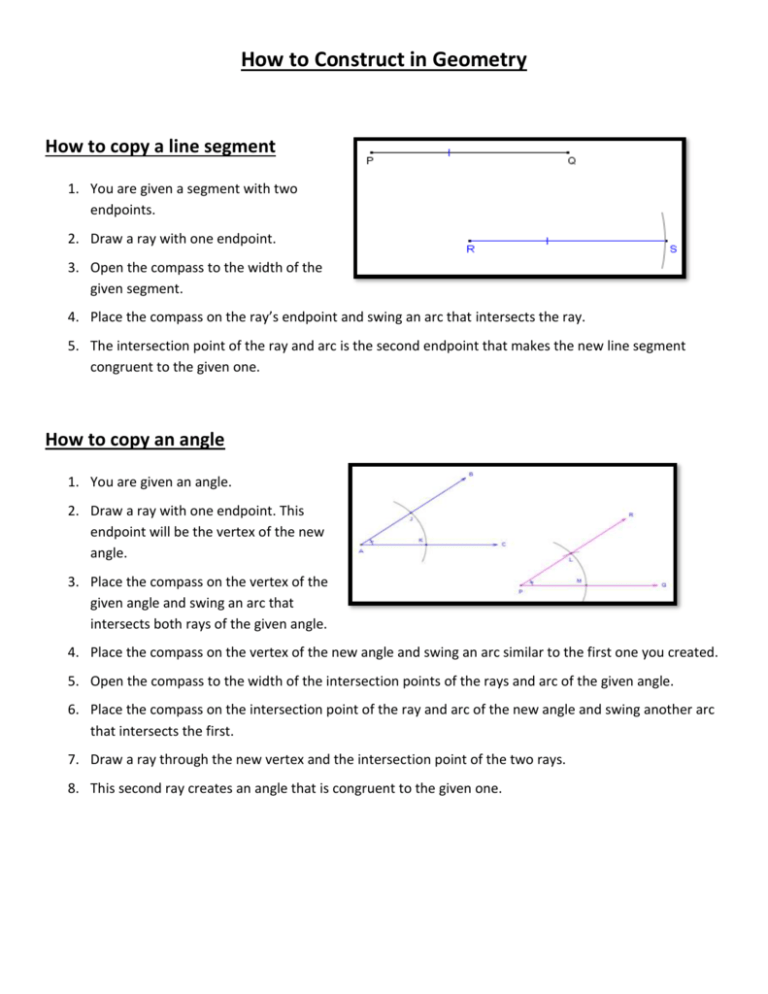
How to Construct in Geometry How to copy a line segment 1. You are given a segment with two endpoints. 2. Draw a ray with one endpoint. 3. Open the compass to the width of the given segment. 4. Place the compass on the ray’s endpoint and swing an arc that intersects the ray. 5. The intersection point of the ray and arc is the second endpoint that makes the new line segment congruent to the given one. How to copy an angle 1. You are given an angle. 2. Draw a ray with one endpoint. This endpoint will be the vertex of the new angle. 3. Place the compass on the vertex of the given angle and swing an arc that intersects both rays of the given angle. 4. Place the compass on the vertex of the new angle and swing an arc similar to the first one you created. 5. Open the compass to the width of the intersection points of the rays and arc of the given angle. 6. Place the compass on the intersection point of the ray and arc of the new angle and swing another arc that intersects the first. 7. Draw a ray through the new vertex and the intersection point of the two rays. 8. This second ray creates an angle that is congruent to the given one. How to construct an angle bisector 1. You are given an angle. 2. Place compass on the vertex of the angle. 3. Swing an arc that intersects both rays of the angle. 4. Mark the intersection points of the rays and arc. 5. Place the compass on one of those intersection points and draw an arc inside the angle. 6. Keeping the compass at the same width, place the compass on the second intersection point and swing an arc that intersects the first. 7. Mark the intersection point of the two arcs and draw a ray from the vertex through this intersection point. How to bisect a line segment 1. You are given a segment with two endpoints. 2. Place the compass on one of the endpoints and open the compass to a distance more than halfway across the segment. 3. Swing an arc on either side of the segment. 4. Keeping the compass at the same width, place the compass on the other endpoint and swing arcs on either side so that they intersect the first two arcs created. 5. Mark the intersection points of the arcs and draw a line through those two points. 6. The point where this new line crosses the given segment is the midpoint and divides the segment in half. How to construct perpendicular lines (using a point on the given line) 1. You are given a line and a point on the line. 2. Mark the intersection point of these two lines. 3. Place the compass on this intersection and swing an arc on either side of this point, making sure to cross the given line on both sides. 4. Mark the two intersection points of the given line and two arcs. 5. Place the compass on one of these intersection points and draw two arcs, one on either side of the given line. 6. Keeping the compass at the same width, place the compass on the second intersection point and draw two arcs, one on either side of the line. Make sure that the two arcs on either side of the line intersect one another. 7. Mark the intersection point of the two arcs on either side of the line. 8. Draw a line through these two intersection points. 9. This new line is perpendicular to the given line. How to construct perpendicular lines (using a point not on the line) 1. You are given a line and a point that is not on the line. 2. Place the compass on the given point and open it so that the width of the compass is more than the distance from the given point to the given line. 3. Swing two arcs that intersect the given line. 4. Mark the two intersection points of the given line and two arcs. 5. Place the compass on one of these intersection points and draw two arcs, one on either side of the given line. 6. Keeping the compass at the same width, place the compass on the second intersection point and draw two arcs, one on either side of the line. Make sure that the two arcs on either side of the line intersect one another. 7. Mark the intersection point of the two arcs on either side of the line. 8. Draw a line through these two intersection points. 9. This new line is perpendicular to the given line. How to construct parallel lines 1. You are given a line. 2. Draw another line that intersects the first line. 3. Place a point on this second line. 4. Place the compass on the intersection point of the first line and the second line and swing an arc that crosses both lines. 5. Keeping the compass at the same width, place the compass on the point on the second line and swing an arc similar to the first—making sure you cross through the second line. 6. Go back to the given line and open the compass to the width of the intersection of the arc and the two lines. 7. Keeping the compass at the same width, place the compass on the intersection point of the second line and the arc and swing another arc that intersects the first. 8. Mark the intersection of the two arcs. 9. Draw a line through the point on the second line and the intersection of the arcs, creating a third line which is parallel to the first. How to construct triangles (all except an equilateral triangle) 1. Create a line and place a point on the line. 2. Place the compass on the given point and swing an arc on either side of this point, making sure to cross the given line on both sides. 3. Mark the two intersection points of the given line and two arcs. 4. Place the compass on one of these intersection points and draw two arcs, one on either side of the given line. 5. Keeping the compass at the same width, place the compass on the second intersection point and draw two arcs, one on either side of the line. Make sure that the two arcs on either side of the line intersect one another. 6. Mark the intersection point of the two arcs on either side of the line. 7. Draw a line through these two intersection points. 8. You just constructed a perpendicular bisector. 9. Place your first vertex of your triangle where the two perpendicular bisectors intersect. 10. Place your second vertex of your triangle where the arc meets the x axis at the right of the perpendicular bisector. 11. The third point can be placed on various points, depending on what type of triangle you want to construct 12. If you would like your triangle to be acute, place your third point to the right of the perpendicular bisector. If you would like your triangle to be obtuse, place your third point to the left of the perpendicular bisector. If you would like your point to be right, place your point on the perpendicular bisector. 13. If you would like your triangle to be scalene, place your third point off of the arc. If you would like your triangle to be isosceles, place your third point on the arc. How to construct triangles (equilateral/equiangular) 1. Start by creating a segment of any length and mark both endpoints. 2. Open the compass to the width of this segment. 3. With the compass placed one of the endpoints, swing a large arc. 4. Keeping the compass open to the same width, place it on the other endpoint and swing a second large arc. 5. Be sure that the two arcs intersect one another. 6. Mark the point of intersection of the arcs. 7. Connect this intersection point with both of the segment endpoints. 8. The triangle with these vertices is an equilateral, equiangular triangle. How to construct an angle bisector 1. You are given an angle. 2. Place compass on the vertex of the angle. 3. Swing an arc that intersects both rays of the angle. 4. Mark the intersection points of the rays and arc. 5. Place the compass on one of those intersection points and draw an arc inside the angle. 6. Keeping the compass at the same width, place the compass on the second intersection point and swing an arc that intersects the first. 7. Mark the intersection point of the two arcs and draw a ray from the vertex through this intersection point. How to construct an incenter 1. You are given a triangle and asked to construct the incenter. 2. You must construct at least two triangle angle bisectors. 3. The point of intersection of the angle bisectors will be the incenter. 4. To construct a triangle angle bisector you must follow the steps above. Do so with at least two vertices/sides of the triangle. How to construct a median 1. You are given a triangle and must construct a median. 2. Place the compass on one of the vertices and open the compass to a distance more than half way across the triangle side. 3. Swing an arc on either side of this segment. 4. Keeping the compass at the same width, place the compass on another triangle vertex and swing arcs on either side so that they intersect the first two arcs created. 5. Mark the intersection points of the arcs and draw a line through those two points. 6. The point where this new line crosses the triangle side is the midpoint and divides that side in half. 7. Connect this midpoint with the opposite vertex to construct one of the medians in the triangle. How to construct a centroid 1. 2. 3. 4. You are given a triangle and asked to construct the centroid. You must construct at least two triangle medians. The point of intersection of the medians will be the centroid. To construct a triangle median you follow the steps above. Do so with at least two vertices/sides of the triangle. How to construct an altitude 1. You are given a triangle and must construct an altitude. 2. Place the compass on one of the triangle vertices and open it so that the width of the compass is more than the distance from the vertex to the opposite triangle side. 3. Swing two arcs that intersect the opposite side. 4. Mark the two intersection points of the triangle side and two arcs. 5. Place the compass on one of these intersection points and draw an arc on the other side of the segment (the side opposite where the vertex is). 6. Keeping the compass at the same width, place the compass on the second intersection point and draw another arc on the other side of the segment (the side opposite where the vertex is). Make sure that the two arcs intersect one another. 7. Mark the intersection point of the two arcs. 8. Draw a line through this intersection point and the vertex with which you started. 9. Mark the intersection of this perpendicular line and the triangle side. 10. The segment formed by the triangle vertex and the vertex of the 90 degree angle is one of the triangle altitudes. How to construct an orthocenter 1. 2. 3. 4. You are given a triangle and asked to construct the orthocenter. You must construct at least two triangle altitudes. The point of intersection of the altitudes will be the orthocenter. To construct a triangle altitude you follow the steps above. Do so with at least two vertices/sides of the triangle. How to construct a triangle perpendicular bisector 1. You are given a triangle and must construct a perpendicular bisector. 2. Place the compass on one of the triangle vertices and open the compass to a distance more than half way across a triangle side (either side with the vertex as one of its endpoints). 3. Swing an arc on either side of the triangle side. 4. Keeping the compass at the same width, place the compass on the other triangle vertex and swing arcs on either side so that they intersect the first two arcs created. 5. Mark the intersection points of the arcs and draw a line through those two points. 6. The point where this new line crosses the given triangle side is the midpoint and divides the side in half at a 90 degree angle. How to construct a circumcenter 1. 2. 3. 4. You are given a triangle and asked to construct the circumcenter. You must construct at least two triangle perpendicular bisectors. The point of intersection of the perpendicular bisectors will be the circumcenter. To construct a triangle perpendicular bisector you must follow the steps above. Do so with at least two vertices/sides of the triangle. How to construct congruent triangles (SSS) 1. 2. 3. 4. 5. 6. 7. 8. You are given a triangle. Start by copying one of the given triangle sides. Create a random point away from the given triangle. Place the compass on one of the triangle vertices and open it to the width of one of the triangle sides. Keeping that same width, place the compass on the point you created and swing an arc. Mark any point on that arc and connect that with the point you created. This segment is congruent to the first segment of the given triangle. Now, place the compass on another vertex of the given triangle and open it to the width of another one of the triangle sides. 9. Keeping that same width, place the compass on one of the endpoints of the copied segment and swing a large arc. 10. To copy the third side, place the compass on the last vertex of the given triangle and open it to the width of the last triangle side. 11. Keeping that same width, place the compass on the other endpoint of the copied segment and swing an arc that intersects the previous one. 12. Mark the point of intersection of the two arcs. 13. Connect this intersection point with both the endpoints of the first copied segment. 14. This triangle will be congruent to the given triangle because all three corresponding sides are congruent. How to construct congruent triangles (SAS) 1. Your task is to construct a triangle congruent to the one shown using a compass and straightedge. 2. Begin by drawing a segment of any length using your straightedge. 3. Place both ends of your compass at the endpoints of any side of the triangle. For this example, we will use segment a. 4. Without resizing the compass, place its tip on one endpoint of the new segment and draw an arc. The intersection of the arc and segment will be the endpoint of the congruent segment. 5. Now resize the compass so an arc may be drawn around an angle next to the segment you just chose. Let's choose angle ACB. 6. Find the points of intersection between the arc and both segments on the given triangle. We'll label these points L and K. 7. Without changing the compass, draw an arc from an endpoint of the copied segment. Identify the point of intersection as point M. 8. Measure with your compass between points L and K. 9. Now place the tip of the compass on point M and draw an arc that intersects the previous arc. 10. Identify the point of intersection between the two arcs as point R. 11. Create a ray between points D and R. 12. Angle ACB is congruent to Angle RDE. 13. Now, measure the side of the triangle on the other side of the angle using your compass. In this example, the compass will be placed on points A and C. 14. Then, keeping the compass the same width, place the tip of the compass on point D and draw an arc that will intersect with the ray. Label the point of intersection point F. 15. Segment DF is congruent to segment AC. 16. The final step is to use your straightedge to construct a segment between points F and E. 17. Because segment DE is congruent to segment CB, angle ACB is congruent to angle FDE, and segment AC is congruent to segment FD, triangle ACB is congruent to triangle FDE by the Side-Angle-Side Postulate.


